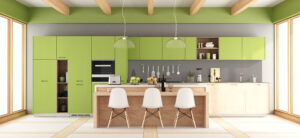A bathroom vanity is a vital piece of furniture that gives your bathroom storage and practicality. With so many options available, selecting the ideal vanity for your room can be overwhelming. Factors such as the vanity’s size, design, and material are crucial.
It should be appropriate for your bathroom’s measurements and offer enough storage to meet your needs. The vanity can be made of any material, including wood, stone, or glass, and can have a conventional or modern design.
The number of sinks, the style of the countertop, the location of the plumbing, and the aesthetic of the overall design are further factors. This buying guide will help you navigate the different options and make an informed decision when selecting a bathroom vanity.
How much space do you have?
The amount of space you have available is one of the major elements to consider when purchasing a bathroom vanity. It’s crucial to measure your bathroom and determine how much space you have before you start shopping.
Width: To make moving around and cleaning easier, leave at least a few inches of room on either side of the vanity. Also, the vanity’s width should match your bathroom’s dimensions. A broader vanity can fit in a larger bathroom, while a smaller bathroom could need a narrower one.
Depth: Some alternatives are shorter or deeper than the typical bathroom vanity depth, which ranges from 18 to 21 inches. A deeper vanity can offer additional storage space, while a shallower one may be a smart choice for a tiny bathroom.
Height: Although 32 to 36 inches is considered the average height, some choices are taller or shorter. A shorter vanity may be a wonderful choice for a child’s bathroom.
Location: Ensure the plumbing matches the new vanity if you replace an existing one. If you’re starting from scratch, you’ll need to organize the vanity’s placement around where the plumbing will be.
You can select a vanity that fits your demands and space by considering these aspects.
Who Will Use It?
The next step in purchasing a bathroom vanity is determining who will use it and how. Is it for a guest bathroom, powder room, or main bathroom? It’s crucial to consider who will use the bathroom vanity and how it will be used before making a purchase. The size of the bathroom, how many people will be using it, and the room’s design and utility will all influence the sort of vanity you select.
If you’re purchasing a vanity for your primary bathroom, you might want a bigger, more opulent one with a double sink and lots of storage space. This will keep everything in your bathroom orderly and enable you and your companion to use the area comfortably.
You might want to pick a smaller, more space-efficient vanity for a powder room or guest bathroom that still offers usefulness. Some bathrooms may benefit from a single sink vanity with a smaller tabletop and storage area.
A vanity lower to the ground is apt if you have kids, so they can use it comfortably. A vanity with lots of storage space for their bathroom necessities, including hairbrushes, bath accessories, and toys, may also be something you want to consider.
If your bathroom is traditional and has an intricate design, you might want to pick a vanity that matches this theme. For a conventional bathroom, a vanity with a classic style and lots of storage space can be a suitable choice.
Types of vanity
There are numerous bathroom vanity types, each with certain features and advantages. The following are some of the most typical kinds of bathroom vanities:
- Bathroom vanities with a single sink: As the name implies, these vanities have just one sink and are a popular option for bathrooms of all sizes. They are flexible for any bathroom because they are available in various sizes, designs, and materials.
- Bathroom vanities with two sinks are perfect for larger bathrooms or couples wanting their private place. Double-sink vanities are a terrific alternative for busy households since they provide more countertop space and storage than single-sink vanities.
- Bathroom vanities that float: These vanities are mounted directly to the wall, creating the appearance of a floating countertop. They provide a sleek, contemporary appearance and help make small bathrooms appear larger.
- Freestanding bathroom vanities can be moved about as needed because they are not mounted to a wall. They are adaptable for any bathroom because they are available in various styles, including traditional, modern, and rustic.
- Corner bathroom vanities are an excellent choice for tiny areas since they can be installed in the corner of a bathroom. They can be found in various designs, from traditional to modern, and they can assist in making the most of the bathroom’s space.
Materials for a bathroom vanity cabinet
Personal preference, financial constraints, and intended longevity determine which material should be used for bathroom vanity. Vanities made of solid wood are considered the strongest and most long-lasting, but they can also be more expensive. Although MDF (medium-density fiberboard) is less expensive, it could not be as sturdy as solid wood.
Vanities may also be made of other materials, such as plywood and particleboard. When selecting a material for a bathroom vanity, it’s crucial to consider the benefits and drawbacks of each option as well as your budget and personal preferences.
What Materials Are Used for Bathroom Vanities Countertops?
There are many materials for bathroom vanity countertops, and each has special qualities, advantages, and disadvantages. Some of the more well-liked choices are as follows:
- Granite is a natural stone that is incredibly hard and resistant to heat, stains, and scratches. It is a flexible solution for any bathroom because it comes in various colors and designs.
- Marble: Marble is another tough natural stone with a timeless, refined appearance. It can, however, be more susceptible to scratches and stains than granite.
- Quartz: Quartz countertops are made of crushed quartz and resin, which makes them incredibly strong and stain- and scratch-resistant.
- Laminate: Laminate countertops come in various colors and designs and are cost-effective. They can, however, be vulnerable to scratching and chipping and are not as strong as other materials.
Bathroom Vanity Styles
There are numerous alternatives to pick from when it comes to bathroom vanity styles, ranging from conventional to modern and everything in between. Here are a few trendy looks to take into account:
- Traditional: Ornate elements like raised panel doors, ornamental moldings, and hardware with exquisite designs are typical of traditional vanities. They come in a range of wood finishes and frequently have a warm, traditional appearance.
- Modern: Modern vanities frequently consist of materials like metal, glass, or engineered wood and have a simple, minimalistic appearance. They frequently have a sleek, modern appearance and may feature straight lines and geometric designs.
- Natural materials with a worn or aged appearance, such as reclaimed wood or stone, make rustic vanities. They are preferred in homes near lakes or mountains because they have a warm, cabin-like vibe.
- Transitional: Transitional vanities combine traditional and contemporary characteristics. They include straight lines and straightforward designs with elaborate accents like raised panel doors or elegant hardware.
When choosing a bathroom vanity style, it’s important to consider the overall design of your home and how the vanity will fit in with the rest of the space. You can create a cohesive and stylish bathroom design by choosing a style that complements your home’s aesthetic.
Where to Purchase Bathroom Vanities
Bathroom vanities can be purchased from various stores, including furniture stores, home improvement stores, and online merchants. Personalized design services and a large selection of vanities may also be found at specialty kitchen and bath retailers like Impressions Kitchens. Before making a purchase, researching and comparing costs, reviews, and shipping alternatives is crucial. Before making a decision, visiting a store in person may also be beneficial to see and touch the vanities.







